Pigeons
A guide to clinical findings for vets in practice.
Contents
- Clinical exam of a pigeon video
- Wood pigeons
- Collared Doves
- Feral pigeons
- Trauma: collisions
- Trauma: catted
- Trauma: feather loss
- Trauma: 'Sparrowhawked'
- Trapped/entangled: stuck in chimney
- Infection: ticks (tick-related syndrome)
- Infection: feather lice
- Infection: trichomonosis (canker)
- Infection: salmonellosis (paratyphoid)
- Infection: pigeon paramyxovirus
- Infection: pigeon pox
- Infection: the 'sick pigeon'
- Developmental disorders: metabolic bone disease (MBD)
- Developmental disorders: poor feathering
- Racing pigeons
Clinical exam of a pigeon
Wood pigeons
Adult
Wood pigeon: adult
Note the white collar, rose-coloured chest, and pink and orange beak. They have symmetrical white patches on each wing.
The apparently misshapen pupil is normal and is the result of black pigmentation on the iris.
Convex chest profile, weighing around 5-600g.
Adult wood pigeons do not cope well with captivity, and are prone to injuring themselves, and damaging/losing their feathers, during confinement or handling.
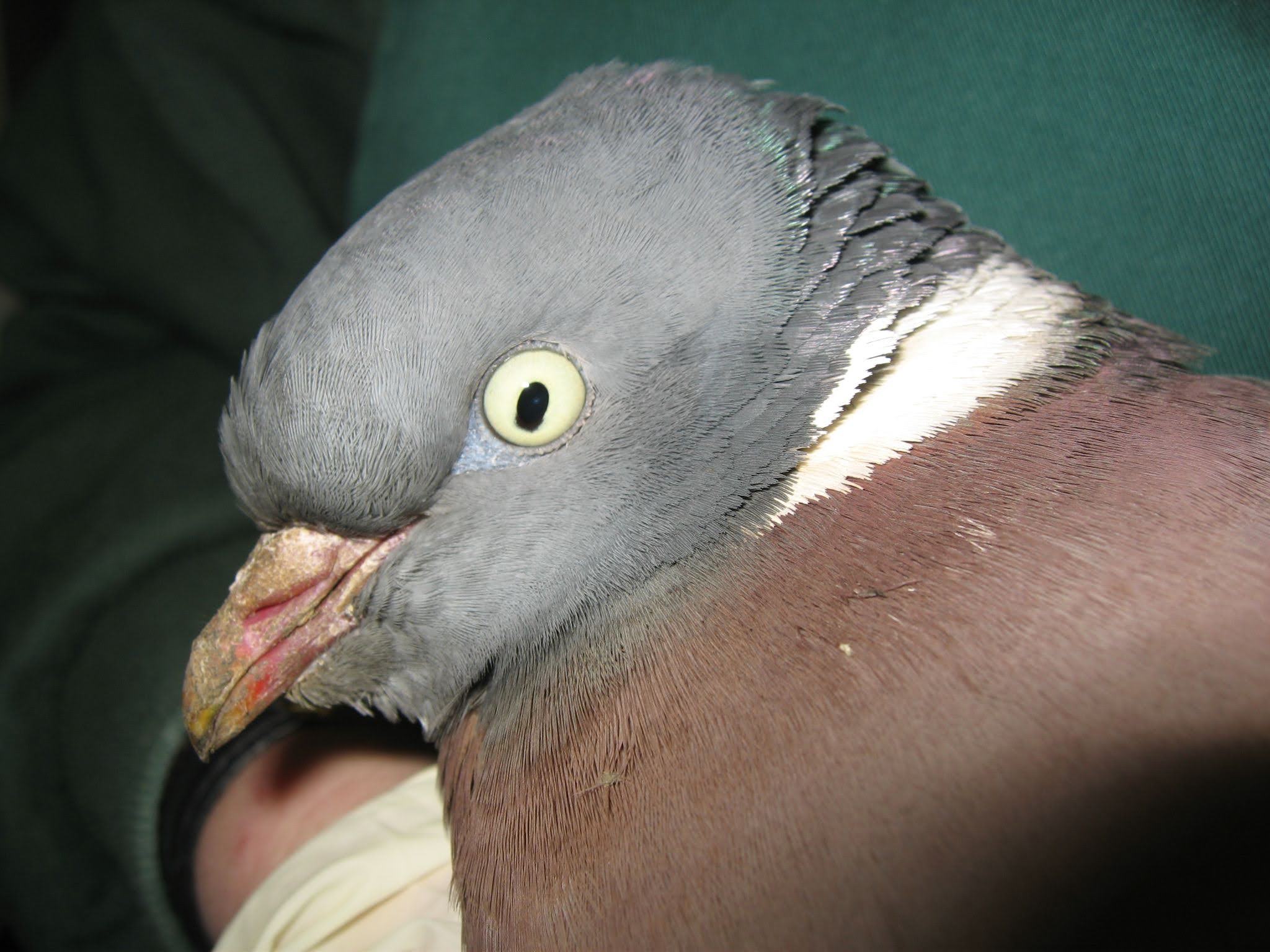
Fledgling
Wood pigeon: fledgling
Young wood pigeons lack the white collar and colourful beak of the adult. Their irises are dark. They do have the rose-coloured chest and white patches on each wing.
Fledglings cope better with captivity than adult wood pigeons. However, they are still more fractious than feral pigeons, and are prone to cage trauma, including flight feather damage.
They can take some time to learn how to eat for themselves, requiring handling for crop tubing multiple times per day. This should be taken into account when considering the treatment of any trauma.

Collared doves
Adult
Collared dove: adult
Collared doves are small (170-240g), with a black collar. They are more flighty, and less robust, than feral pigeons, although they are less prone to cage trauma than wood pigeons.
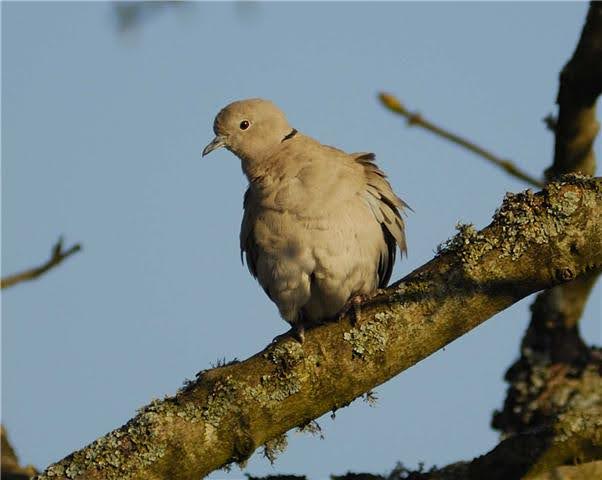
Fledgeling
Collared dove: fledgling
Fledgling collared doves lack the black collar seen in the adult.
They can take some time to learn how to eat for themselves, requiring handling for crop tubing multiple times per day. This should be taken into account when considering the treatment of any trauma.
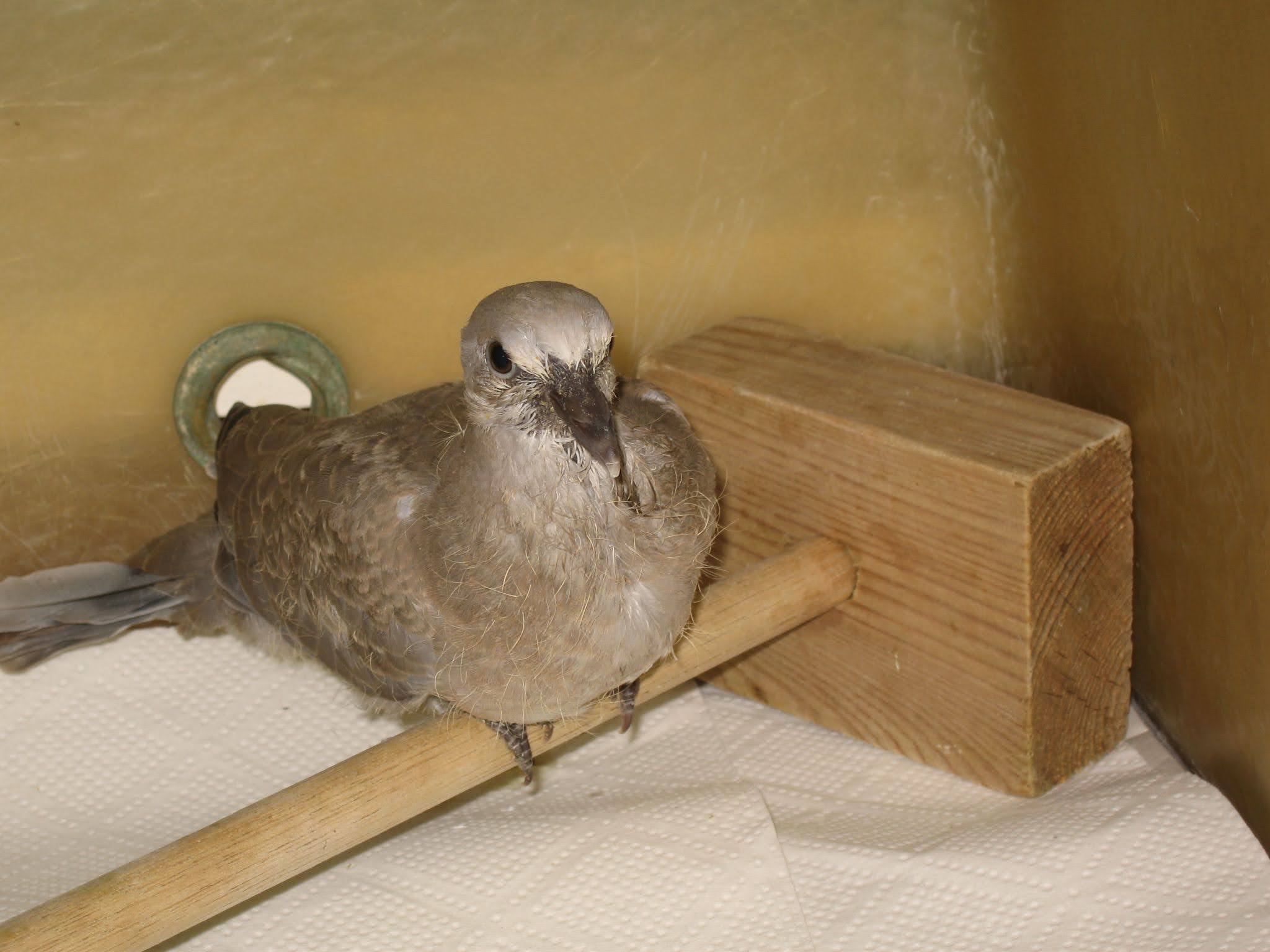
Feral pigeons
Adult
Feral pigeon: adult
Feral pigeons come in a variety of colours.
Feral pigeons cope well in temporary captivity. They are relatively unafraid of people, are capable of feeding themselves from a young age, and have sturdy flight feathers which do not break easily when confined or handled.
Trauma: collisions
General presentation
Birds often found ‘grounded’ in garden. Finder may be aware of bird having hit patio doors or a window. Often (more naive) fledgling birds.
May be seen being hit by car, or found at side of road.
Signs
With window strike, often no fractures are immediately obvious. However, if the bird is placed on the ground and observed, asymmetrical wing carriage, often with a raised wing held across the bird’s back, suggests the presence of damage to the pectoral girdle (shoulder) - frequently a fractured coracoid or clavicle.
Noisy breathing, as a result of blood in the trachea, may be heard.
May have extensive soft tissue/bony damage if hit by car.
May have significant feather loss.
Diagnosis
May be possible on palpation. Radiography useful to confirm fractures to the pectoral girdle (although see prognosis).
Prognosis
The prognosis for any fractures, or obviously abnormal wing carriage, in wood pigeons or collared doves is poor.
Although fractures of the coracoid will heal, the resulting shoulder stiffness will prevent normal flight.
The prognosis for injuries involving joints in any pigeon is poor.
The prognosis for extensive soft tissue trauma is poor.
Note
Blunt-force trauma to the chest can result in blood in the trachea (which may be visible in the mouth). If noisy breathing is apparent, prepare for euthanasia before picking up the bird, to avoid asphyxiation on handling.
In general, feral pigeons have a better prognosis with regard to trauma, although rehabilitation should still only be considered when perfect healing is anticipated.
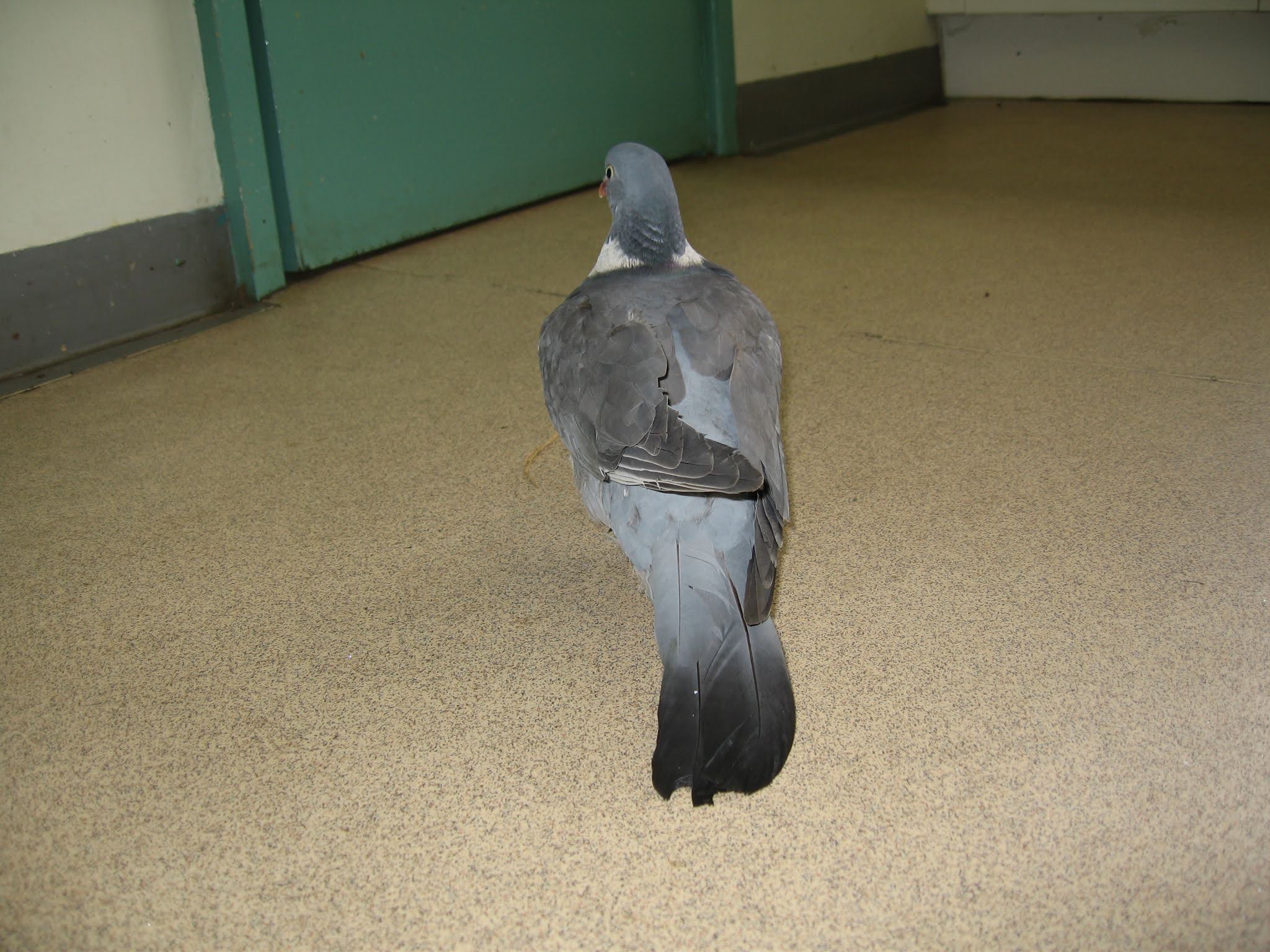
Trauma: catted
General presentation
Finder may have observed bird being catted, there may be signs of trauma of unknown origin, or the bird may just present as a ‘grounded’ juvenile or adult.
Signs
Wounds may be obvious, with blood-matted feathers, or occult. Look carefully through the feathers. If there is one puncture wound, there are generally more (in the pattern of the cat’s bite).
Feather loss may also be present.
Prognosis
Consider euthanasia for anything more serious than skin tears. If there are deep puncture wounds, with muscle involvement, the prognosis is poor, given the likely degree of any underlying muscle damage, and the potential for sepsis.

Trauma: feather loss
General presentation
Regardless of the cause of trauma, feather loss in wood pigeons is very common, causing them to present as ‘grounded.’ They ‘drop’ feathers easily, which is apparent on handling. (For this reason, vinyl examination gloves should be worn when handling, rather than latex.)
Signs
Missing flight feathers.
Associated trauma.
Inability to fly.
Prognosis
Although ‘dropped’ flight feathers will grow back, this will involve several weeks of confinement, which is stressful for the bird, and carries the risk of cage trauma. Euthanasia is recommended in adult wood pigeons which cannot fly.
Note
It is not uncommon to find feral pigeons which have had their flight feathers cut with scissors (all of the same length with a neat edge).
Broken/cut flight feathers can be plucked under G.A. (once the feather is no longer growing (in-pin), to avoid damaging the dermal papilla) and will grow back over the course of a few weeks.
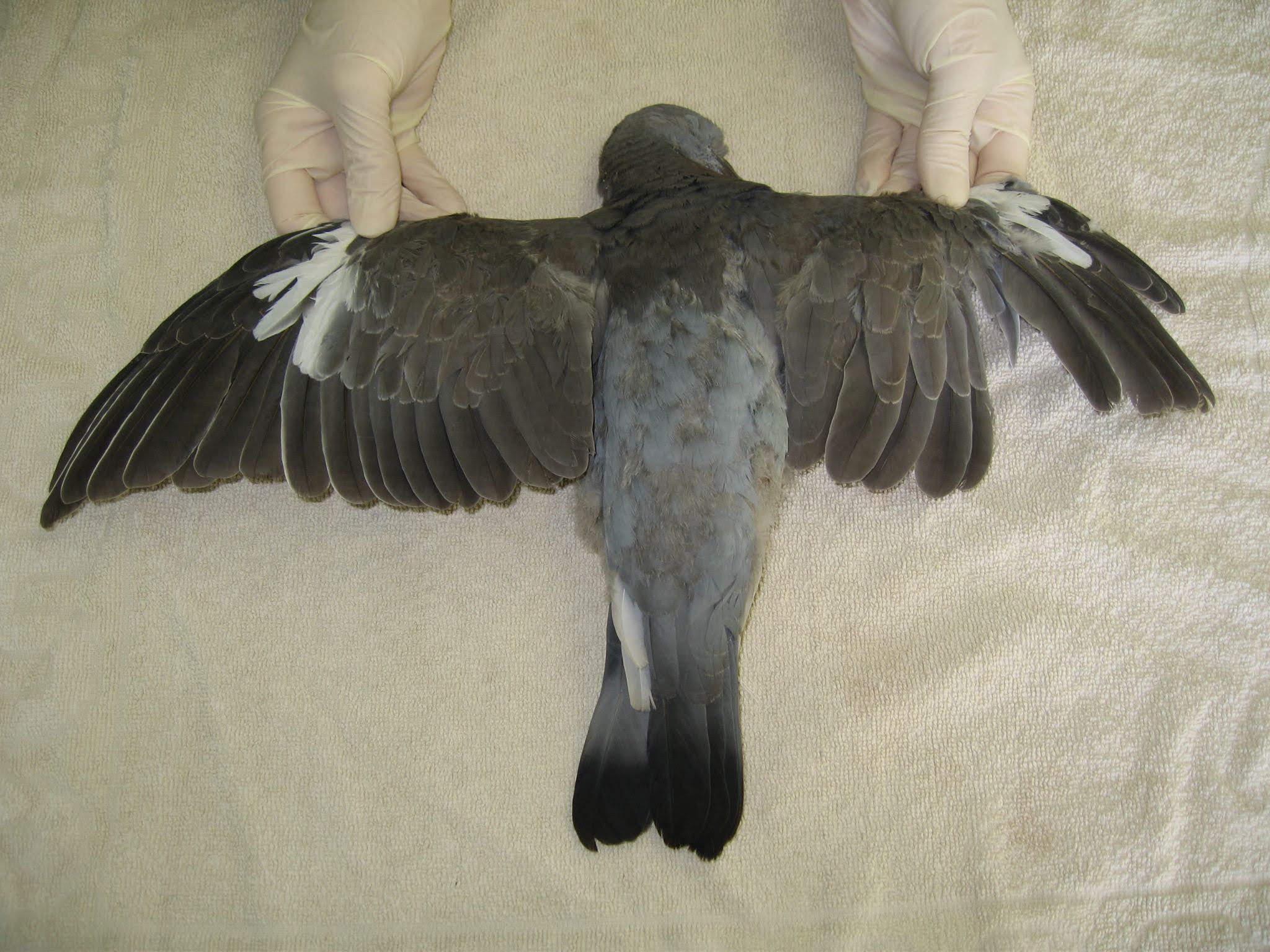
Trauma: ‘sparrowhawked’
General presentation
Finder may have observed bird being ‘sparrowhawked,’ there may be signs of trauma of unknown origin, or the bird may just present as a ‘grounded’ juvenile or adult.
Signs
Wounds generally multiple and obvious, often affecting the ventral neck and back. Holes into crop associated with leaking crop contents (grains etc.).
Feather loss.
Prognosis
The prognosis is poor, as the wounds are often extensive, with muscle involvement and damage to underlying tissues, such as the crop. The necessity for repeated handling and crop-tubing should be considered in a fledgling bird.
Avoid
Avoid repairing holes in the crop by suturing the crop and overlying skin together en masse.
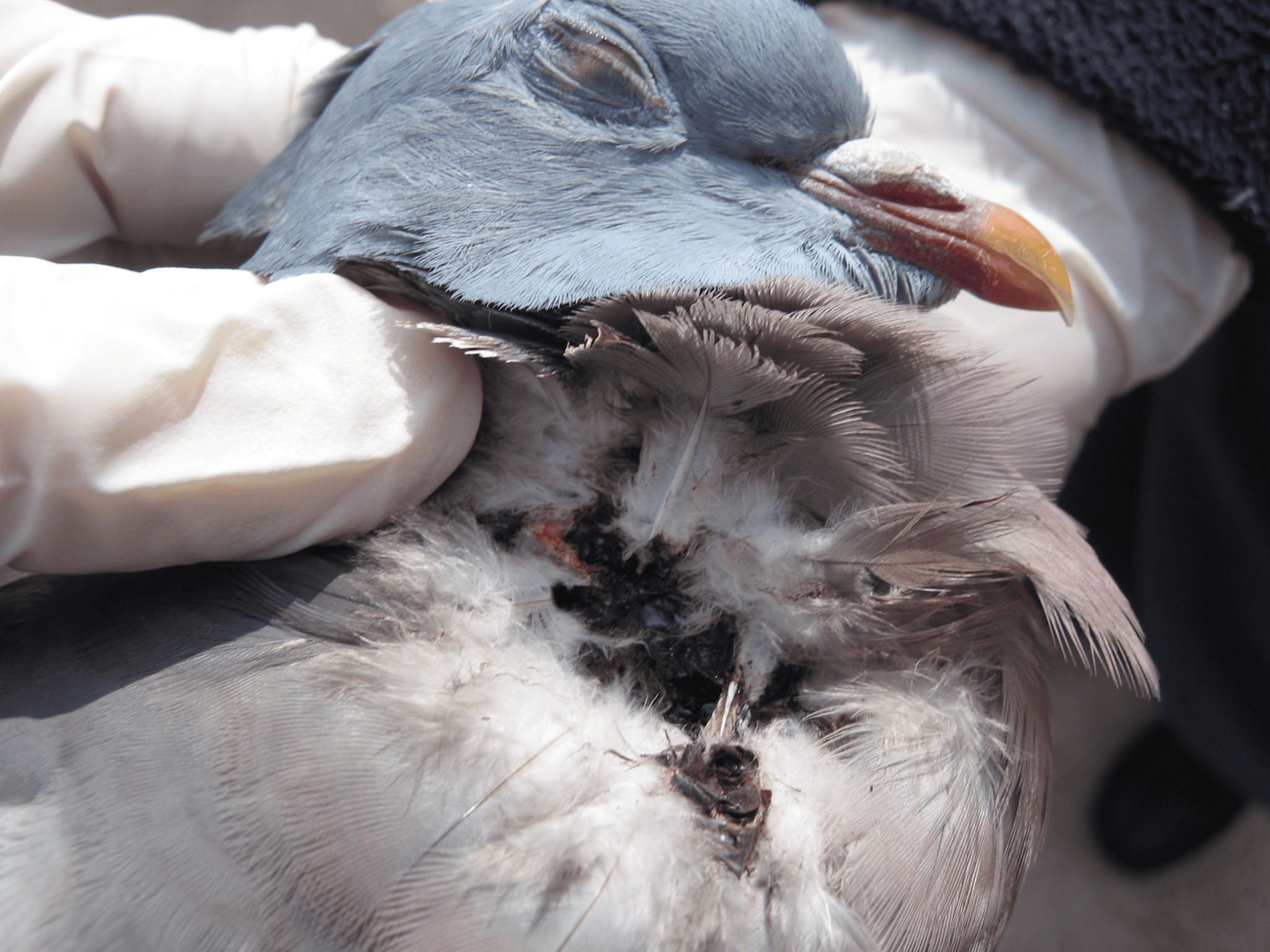
Trapped/entangled: stuck in a chimney
General presentation
Problem of wood pigeons. History of being stuck in chimney.
Signs
Often emaciated as have frequently been trapped for some time.
Frequently have abrasions to carpal and metacarpal regions. The injuries to the carpi are often hidden by feathers, and may appear insignificant (being only 2-3mm long). However, the associated exposure of underlying bone/tendons, and their contamination with soot, often preclude successful treatment.
Damage to flight feathers.
Prognosis
Poor if emaciated, bone/tendons are exposed and contaminated, and extensive feather damage.
Note
Scant, green droppings are a common feature of any bird which has been starved.

Infection: ticks (tick-related syndrome)
General presentation
Generally a problem of collared doves. Often present ‘grounded’ with noticeably swollen head, leading to closure of eye/s. Ticks may be present or have fallen off by this point.
Signs
Swollen head.
Closure of eye/s on affected side/s.
May be tick/s present - or may have crusty lesion where tick was attached. Tick is often hidden by feathering on forehead (not obvious, as in photo).
Prognosis
Often good. Swelling reduces rapidly with tick removal and NSAID/antibiotic treatment.

Infection: feather lice
General presentation
Often a problem of feral pigeons. An incidental finding in birds presenting for any reason.
Signs
Lice most obvious (as small, thin, dark areas) on underside of wing.
Severely louse-chewed feathers have a ‘moth-eaten’ appearance.
Prognosis
Good. Lice easily treated. As feral pigeons cope well in captivity, young birds with poor feathers can be kept in an aviary for a few months until they have completed their ‘post-juvenile’ moult.
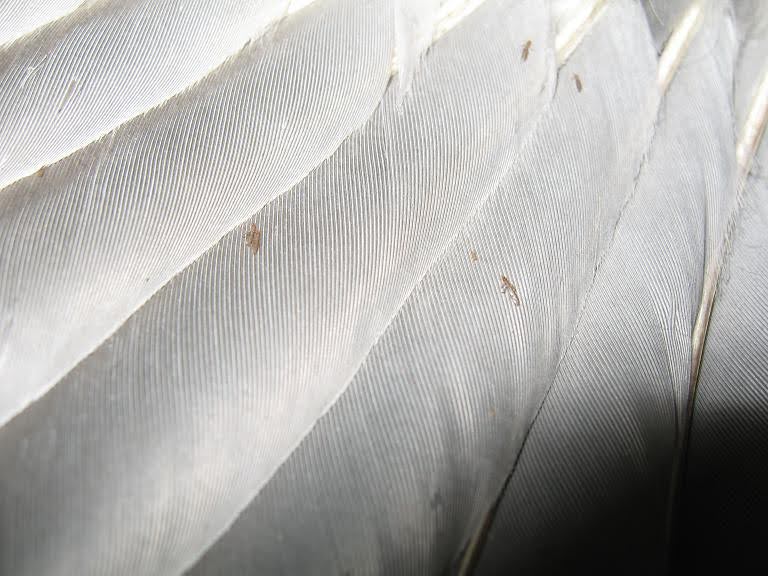
Infection: trichomonosis (canker)
General presentation
Wood pigeons/collared doves
Birds often present in advanced state of disease, by which point they are emaciated and unable to fly; they are frequently presented as ‘grounded.’
Feral pigeons
Earlier lesions may be found as an ‘incidental’ problem in young feral pigeons which have fallen from nest.
Signs
Wood pigeons/collared doves
The chest profile is concave, with a prominent keel.
There may be an obvious bulge in the crop, below the lower beak.
The feathers around the mouth may be contaminated with food and sticky saliva.
The bird/mouth may have a sickly aroma.
On opening the beak, caseous whitish-yellow lesions can be seen on the roof of the mouth and in the oropharynx.
Feral pigeons
Earlier lesions present as small whitish-yellow plaques on roof of mouth.
Diagnosis
This can be based with a high degree of accuracy on presenting signs.
It can be confirmed by smearing the lesions with a wet cotton bud, adding a further drop of warm water to the end of cotton bud under a warm tap, then allowing this drop of water to hang off the end of the cotton bud for a few moments (concentrating the trichomonads), before dropping it onto a slide and examining under the microscope for the presence of the motile trichomonads.
Prognosis
Wood pigeons/collared doves
As the disease is generally advanced at the time of presentation, with extensive invasion of the oropharynx and surrounding tissues, and resulting emaciation, euthanasia should be performed.
Feral pigeons
Early lesions, without extensive invasion of soft tissues, may be treated with metronidazole.
Avoid
Metronidazole cannot be used in wood pigeons as they are a game species, and may enter the human food chain.
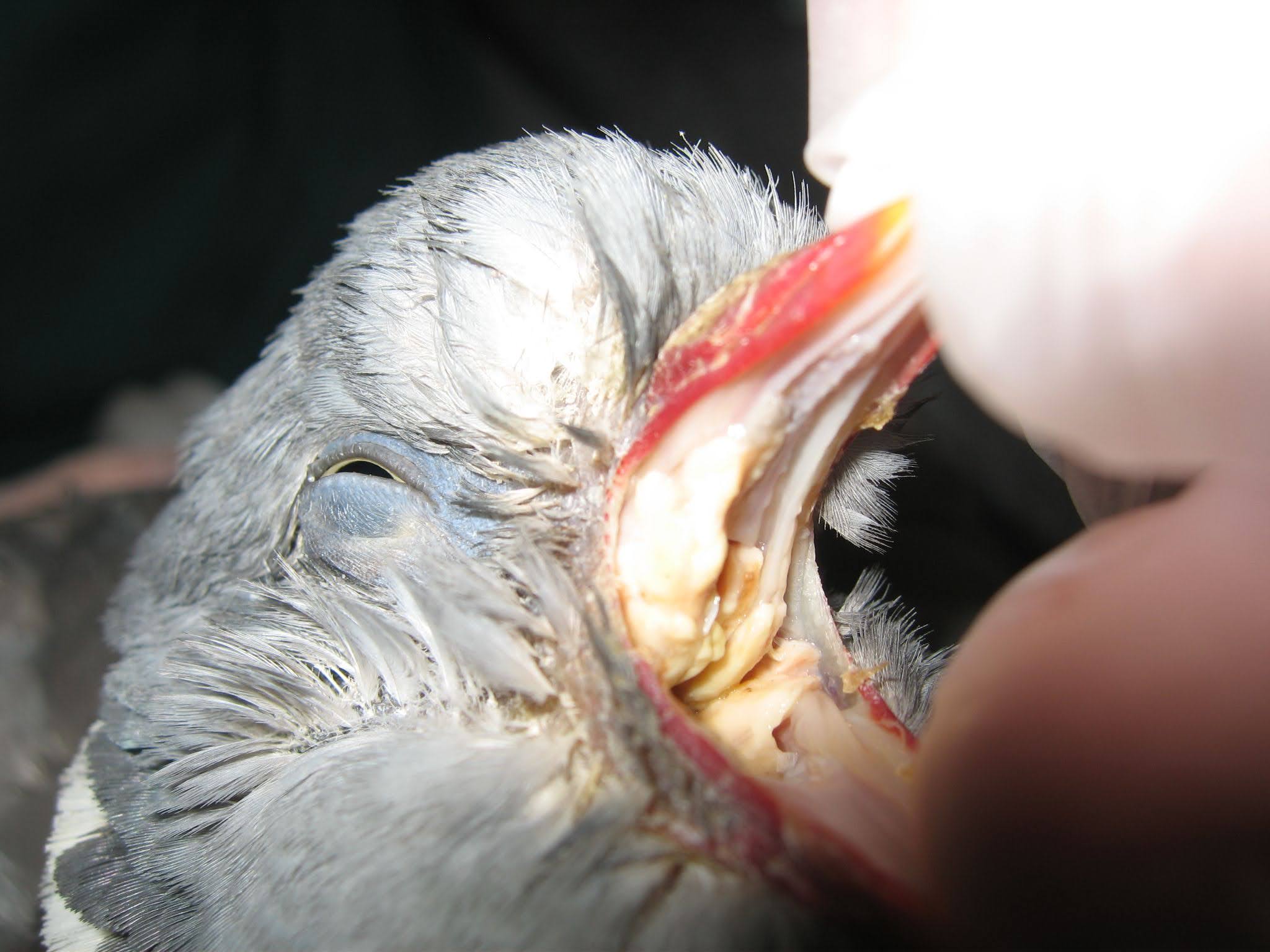
Infection: salmonellosis (paratyphoid)
General presentation
Bird found grounded.
Signs
Depending on location of infection, may exhibit:
Enteritis.
Swollen joint(s) as a result of septic arthritis; lameness or poor wing carriage depending on joint(s) involved.
Neurological signs e.g. torticollis.
Diagnosis
Often presumptive with joint disease or neurological signs.
Prognosis
Poor. Euthanasia of birds with swollen joints or neurological signs should be performed, regardless of cause.
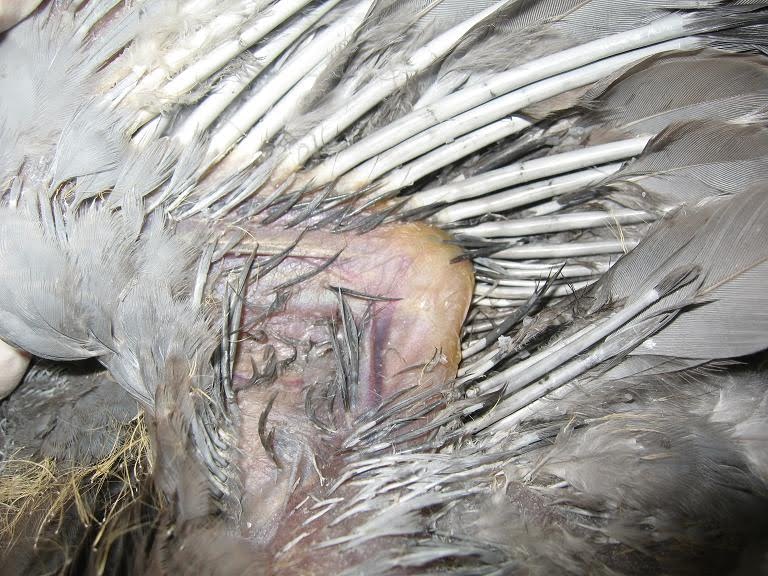
Infection: pigeon paramyxovirus
General presentation
Generally a condition of feral pigeons. May present ‘grounded’ or may be an ‘incidental’ finding in a bird presented for other reasons.
Signs
Watery droppings.
Head tremor.
Uncoordinated pecking at food.
Torticollis in advanced cases.
Diagnosis
Presumptive. Neurological signs develop after enteric signs and may be as subtle as a slight head tremor. In advanced cases, torticollis may be exhibited when the menace response is tested by bringing the palm of a hand towards the bird’s head rapidly. The disease is often endemic in particular areas, so pay particular attention to birds from areas from which you have received multiple birds with suggestive signs.
Prognosis
Highly contagious with a poor prognosis for recovery so euthanasia should be performed.
Note
PPMV-1 in feral pigeons is not a Notifiable Disease.
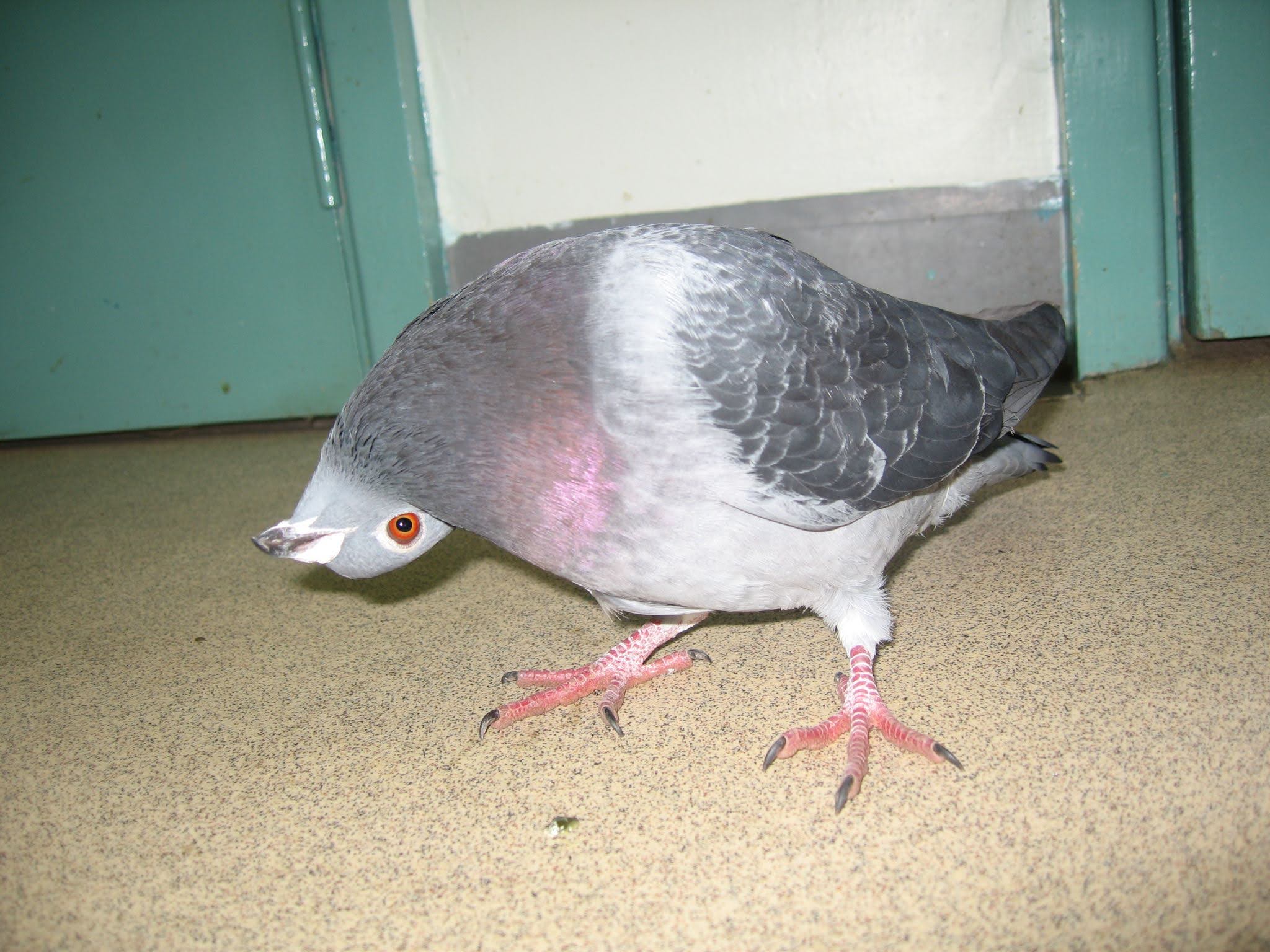
Infection: pigeon pox
General presentation
May be an ‘incidental’ problem in birds which present for any reason.
Signs
Typical pox lesions on head - less commonly on legs and feet.
Diagnosis
Based on clinical findings.
Prognosis
Lesions may resolve over 3-4 weeks. However, highly contagious - consider risk to other birds.

Infection: the ‘sick pigeon’
General presentation
Generally a problem of feral pigeons. Bird presents ‘grounded.’
Signs
Fluffed-up.
Emaciated.
Eyes closed.
May have runny eyes.
May have diarrhoea.
No sign of trauma.
Prognosis
Feral pigeons may suffer from a number of infections with non-specific presenting signs, including chlamydiosis, and so pose a risk to other birds and to humans. Euthanasia should therefore be considered in any obviously sick bird.
Developmental disorders: metabolic bone disease (MBD)
General presentation
A problem of wood pigeons and collared doves. Often present as ‘grounded’ fledglings. May be obviously lame or have dropped wings.
Signs
Lameness or dropped wings as a result of fractures (may be obviously palpable or microfracture).
Soft, bendy mandibles may be apparent on opening the beak.
Twisted toes.
Deformed long bones of the leg.
Deviated keel.
Poor quality, stress-marked feathers.
Prognosis
Once deformities of the bones are present, these are not correctable (given the poor bone quality and fact that the bird will have to be handled multiple times per day in order to be fed) so euthanasia should be performed.
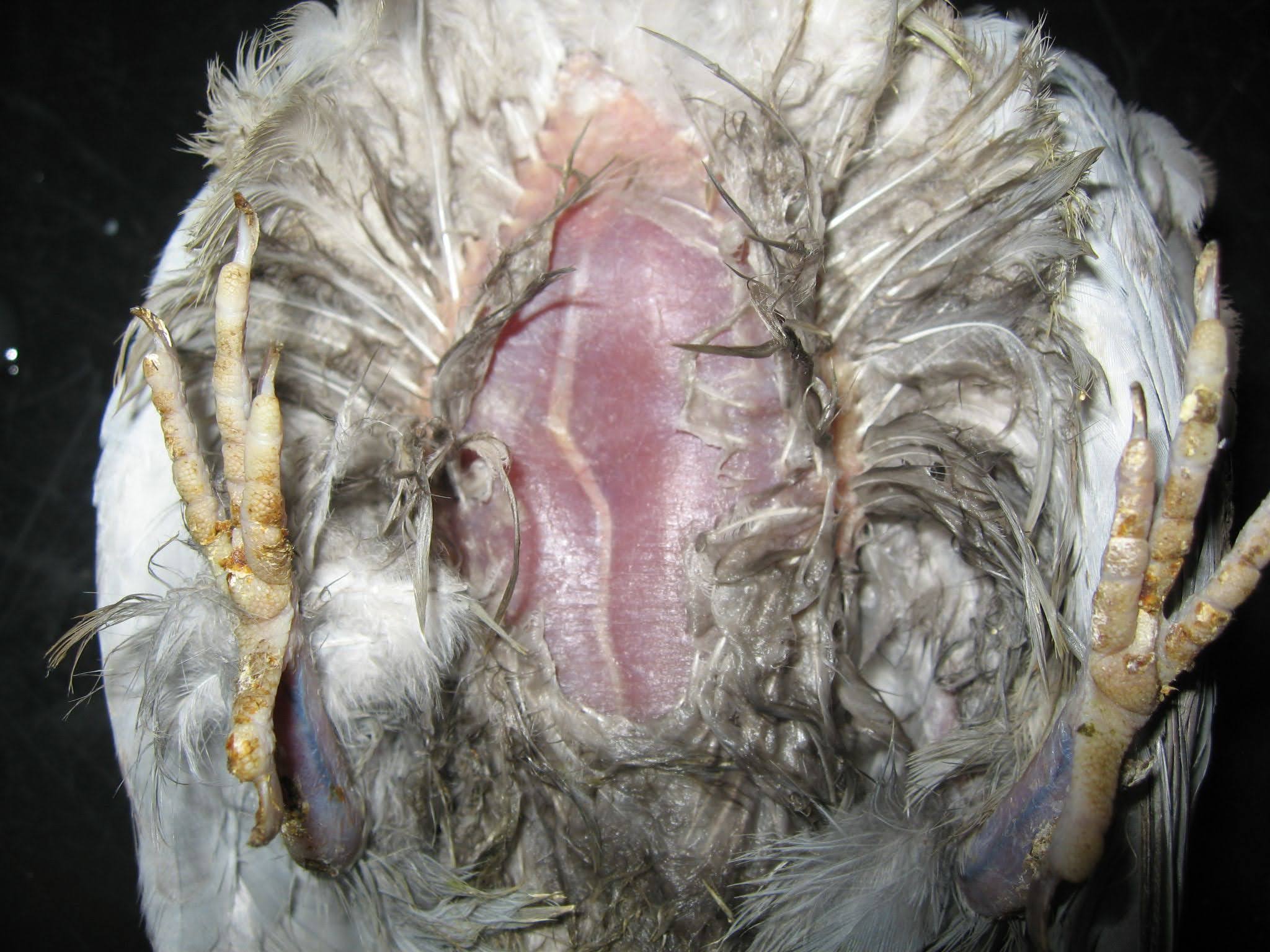
Developmental disorders: poor feathering
General presentation
Often present as ‘grounded’ fledglings. Poor feathering may be an incidental finding in young birds presenting for any reason.
Signs
Stress marks (translucent lines perpendicular to the shaft of the flight feathers).
Retained sheathes on tail feathers giving appearance of long, thin rods (collared doves - see next slide).
May be found in conjunction with MBD (see previous slide) given association with ‘poor start.’
Prognosis
Depends on extent of problem. As flight feathers all growing at same time in nest, stress marks are found at same level along lengths of shafts. As a consequence, feathers all likely to snap at the same point, compromising flight. Check shaft of feathers for obvious ‘dents’ at level of stress mark - this is where the feather will break. All pigeons will do a complete post-juvenile moult; if capable of flight they may be housed in a suitable aviary until this has happened, prior to release.
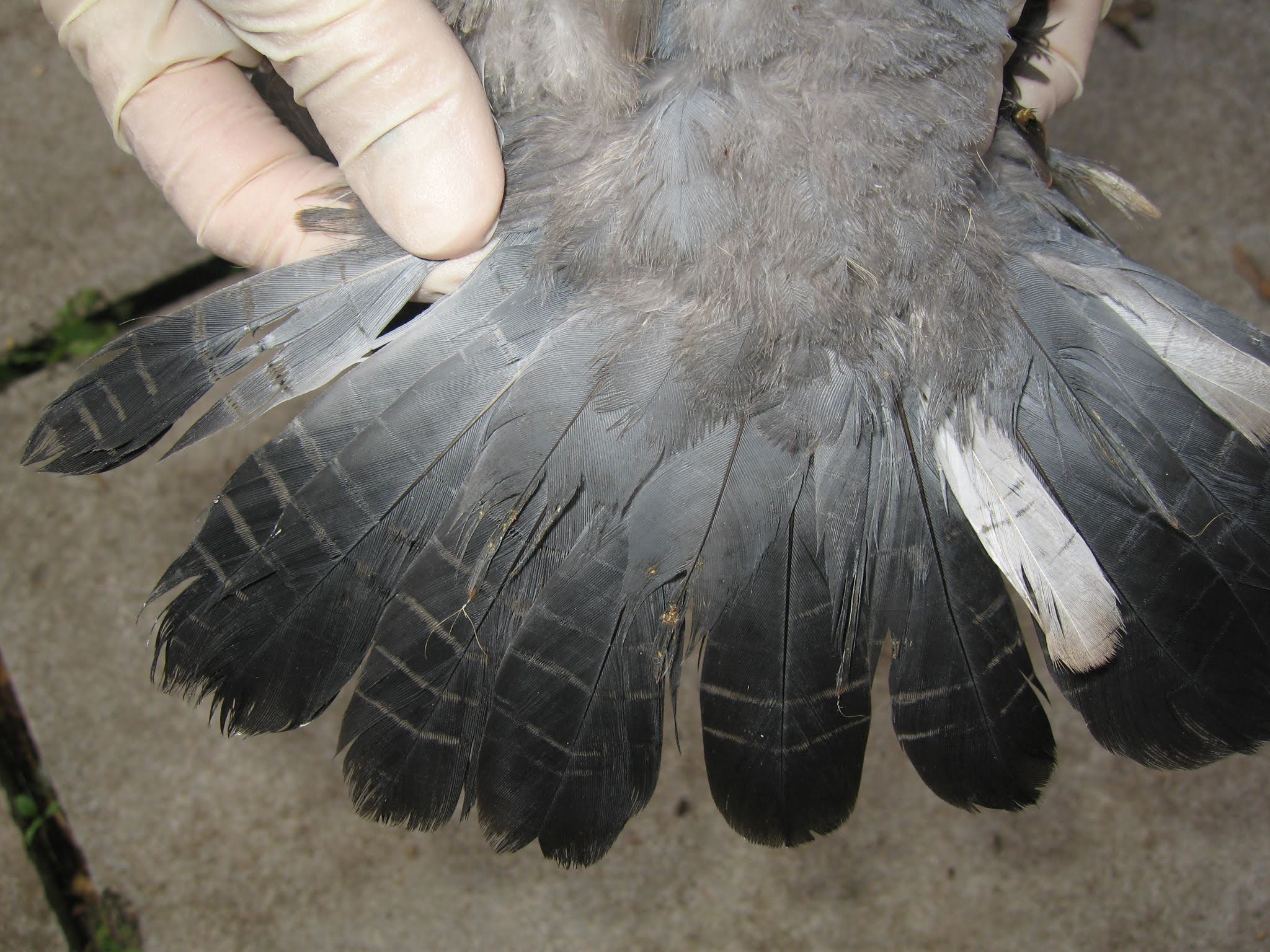
Racing pigeons
General presentation
Often found ‘grounded.’ May be thin and exhausted. May have suffered trauma.
Contacting owner
Telephone number of owner may be on leg ring or stamped on primary feathers.
Ring prefix: GB
Call Royal Pigeon Racing Association on 01452 713529
Ring prefix: IHU
Call Irish Homing Pigeon Union on 003531 84210165
